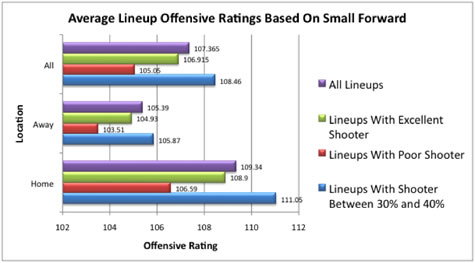| Basketball-Statistics.com | Innovative Stats and Analysis | |||||||||||
|
|||||||||||
|
|
by Jon Nichols The small forward position is one of the most critical positions in basketball. In most cases, the other four positions have specific responsibilities that don’t change a whole lot from team to team. However, the roles of small forwards are varied. Some teams use them as scorers, others as ball-handlers, others as defenders, etc. The goal of this study today is to determine the importance of three-point shooting ability in small forwards. Using the lineup data at http://www.basketballvalue.com, I’ve split the lineups into three groups: those featuring a small forward who shoots 40% or better on threes, those featuring one who shoots 30% or less, and the remainder. For each group, I’ve calculated the average Offensive Rating. In addition, the lineups are split between those at home and those on the road. The results are in the graph below: 27.01% of home lineups feature a small forward shooting better than 40% on threes, and 21.22% feature one shooting less than 30%. On the road, those numbers are 26.56% and 21.62%, respectively. The results are a bit surprising. Least surprising is the fact that if your small forward is a liability from long range, your offense tends to suffer. Clearly there is some benefit to being able to spread the floor. What is surprising is the fact that lineups featuring a sharpshooter at the small forward position also tend to be worse (although only slightly). Perhaps this reflects the fact that three-point specialists are often limited in other areas. It appears the solution is to have a small forward who shoots somewhere between 30% and 40%. Again, this isn’t because missing shots is in some way beneficial. It’s most likely because the best shooters are the most likely to have the biggest weaknesses in other areas. I don’t want to generalize too much, though, and there could be a number of hidden explanations for this. For now, I’ll present the data and let you draw your own conclusions.
Copyright © 2009 Basketball-Statistics.com |
|||||||||
